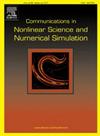Prescribed-time tracking synchronization of Kuramoto oscillator networks with directed graphs via sine function-based control protocol
IF 3.4
2区 数学
Q1 MATHEMATICS, APPLIED
Communications in Nonlinear Science and Numerical Simulation
Pub Date : 2025-02-25
DOI:10.1016/j.cnsns.2025.108691
引用次数: 0
Abstract
This paper investigates the prescribed-time tracking synchronization (PTS) of Kuramoto oscillator networks (KONs) with directed graphs. Existing control protocols for achieving KONs’ synchronization within a finite time are based on linear or power functions of phase differences, but they ignore the -periodicity of phase oscillators. This leads to desynchronization and dramatic phase changes, increasing system load, failure rates, and control costs. To overcome these drawbacks, we propose a sine function-based protocol, incorporating the periodicity of oscillators, to achieve tracking synchronization within a prescribed time. Then a new cosine-based error variable is introduced to characterize the degree of tracking synchronization. By leveraging the error variable and constructing an ingenious Lyapunov function, we establish relaxed criteria for achieving PTS of KONs with the proposed protocol. The condition of the graph containing a directed spanning tree is the weakest, and the initial phases can be almost global. Moreover, we demonstrate the boundedness of the protocol. Finally, numerical simulations validate our results’ effectiveness and superiority compared in others.
求助全文
约1分钟内获得全文
求助全文
来源期刊

Communications in Nonlinear Science and Numerical Simulation
MATHEMATICS, APPLIED-MATHEMATICS, INTERDISCIPLINARY APPLICATIONS
CiteScore
6.80
自引率
7.70%
发文量
378
审稿时长
78 days
期刊介绍:
The journal publishes original research findings on experimental observation, mathematical modeling, theoretical analysis and numerical simulation, for more accurate description, better prediction or novel application, of nonlinear phenomena in science and engineering. It offers a venue for researchers to make rapid exchange of ideas and techniques in nonlinear science and complexity.
The submission of manuscripts with cross-disciplinary approaches in nonlinear science and complexity is particularly encouraged.
Topics of interest:
Nonlinear differential or delay equations, Lie group analysis and asymptotic methods, Discontinuous systems, Fractals, Fractional calculus and dynamics, Nonlinear effects in quantum mechanics, Nonlinear stochastic processes, Experimental nonlinear science, Time-series and signal analysis, Computational methods and simulations in nonlinear science and engineering, Control of dynamical systems, Synchronization, Lyapunov analysis, High-dimensional chaos and turbulence, Chaos in Hamiltonian systems, Integrable systems and solitons, Collective behavior in many-body systems, Biological physics and networks, Nonlinear mechanical systems, Complex systems and complexity.
No length limitation for contributions is set, but only concisely written manuscripts are published. Brief papers are published on the basis of Rapid Communications. Discussions of previously published papers are welcome.
 求助内容:
求助内容: 应助结果提醒方式:
应助结果提醒方式:


